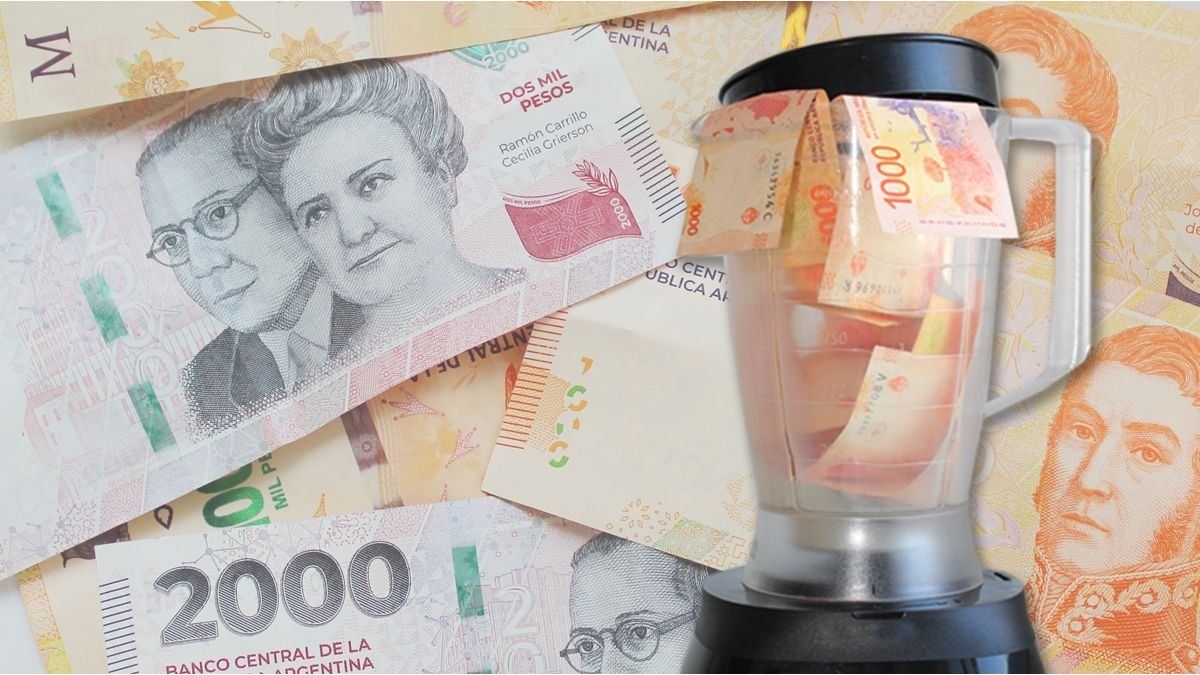The tandem Luis Caputo – Santiago Bausili is embarked on the task of liquefy the weights of the economy in pursuit of lifting, in an increasingly unclear period, the exchange rate. Through the brake on monetary assistance to the treasury (fiscal adjustment shock through) and the policy of super negative rates, in the almost four months of management the economic team used the inflationary flash to reduce in real terms both the circulating money and the stock of paid liabilities of the Central Bank and, consequently, the purchasing power of Argentines’ savings.
From the day before Javier Milei’s inauguration until March 26 (latest official data available), the remunerated liabilities of the BCRA They went from $21.39 billion (between Passes and Leliq) to $31.81 billion (Passes only). This implied a nominal increase of 48.7% of the stock, but a reduction close to 25% in real terms. Towards the middle of the year, the perspective observed by some analysts is that the weight of the Central’s remunerated debt will fall to around 5% of GDP, far from the 10% it represented at the end of 2023.
This trend was due to a combined strategy. The officials appealed to a shock of fiscal adjustment that stopped the issuance to finance the Treasury; to the dollarization of part of the stock of Passes by placing the BOPREAL, the bonus for importers with commercial debt; to the migration of banks’ holdings from BCRA liabilities to Treasury securities, encouraged by the placement of puts or liquidity insurance; and, above all, to the liquefaction generated with the reduction of rates of interest in a context of unleashed inflation. In the market they see signs that this policy will not be modified in the short term and They predict that rates will remain in negative territory for a long time.
The blender also in the BCRA
The blender, which on a fiscal level was used by the Government to adjust pension spending and many other sensitive items at unprecedented speed, also played a determining role for monetary policy from the beginning of the administration. A few days after taking office, Bausili lowered the reference rate from 133% nominal annual rate (around 11% monthly) to 100% TNA (just over 8% monthly). And he did it at a time when inflation jumped from 12.7% in November to 25.5% in December after the impact of the megadevaluation.
This remained the case until March. This month, after the publication of the February CPI (which gave 13.2%), the BCRA decided to cut the interest rate again to 80% TNA (6.6% monthly) while deregulating the minimum rate that governed for retail fixed terms. The objective was to reduce the amount of monthly monetary emission carried out by the entity to pay interest to the banks for their holdings of Passes. By running below inflation, it helps reduce the stock of remunerated liabilities in real terms. Of course, the other side of this is the strong liquefaction of savings deposited in fixed terms.
The objective behind this strategy, which official dispatches describe as “transitional”, is to pave the way for the lifting of the stocks. That is, reduce the mass of pesos that could potentially put pressure on the dollar when exchange restrictions are lifted. Due to the speed of the blender, some analysts suggested that the possibility of disassembling the controls was close.
But in recent weeks both Caputo and Javier Milei have insisted that they do not want to take risks and that the trap will continue until the BCRA’s paid liabilities are reduced to a minimum or until they receive a strong injection of dollars (here the mention is to the open negotiation with the IMF to try to obtain new debt). It happens that, despite the Central Bank’s foreign currency purchases leveraged by a growth in commercial debt, net reserves remain in negative territory and officials fear they do not have the firepower to face a possible run.
Stocks and rates: the market decodes signals
In this context, in the market They decode signals and observe They price a scenario of negative rates that will continue its course. In other words, there are those who predict that if the slowdown in inflation continues, it will be necessary to prepare for a new lowering of the reference interest rate.
One of the signs appeared was the return of the LECAP in the latest Treasury debt tender. These are fixed-rate, capitalizable bills, which were placed at an effective monthly rate of 5.5%, below what the BCRA Repos (6.8%) and the BADLAR (5.9%) pay today. ). The signal is that the LECAP at these levels makes sense if a scenario of inflation and a falling reference rate is anticipated.
“If one thinks that inflation continues to decline in the near future, the central bank will continue to reduce interest rates and therefore it may be that when you go to renew your fixed term in 30 days the rate will be less than 5% effective monthly,” posted on his X account Ariel Sbdarfounder of Cocos Capital, in a message that was retweeted by the advisor to the Ministry of Economy Federico Furiase.
In that sense, the consultant 1816 stated: “That the Treasury has placed a 10-month fixed rate instrument, a term that was frankly unthinkable on December 20, when it had gone on the market with a 27-day Lede, is another example of how much financial conditions have improved in recent years. months. The fact that there have been positions for $2.2 billion and that the cut-off rate has been lower than the performance of Money Markets shows that the market (i) is genuinely optimistic about disinflation and/or (ii) believes that the Central Bank will continue its monetary policy of financial repression (stocks and very negative real rates) to continue reducing the monetary overhang, and is willing to pay a considerable cost (in terms of carry and rate risk) to hedge against that scenario.”
Source: Ambito




